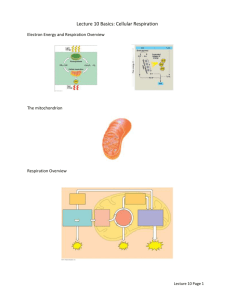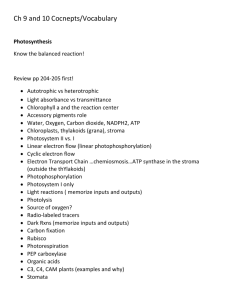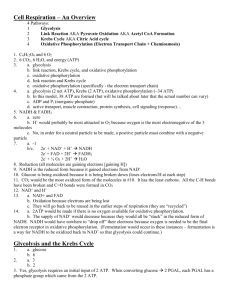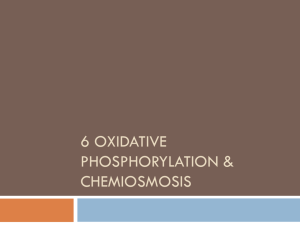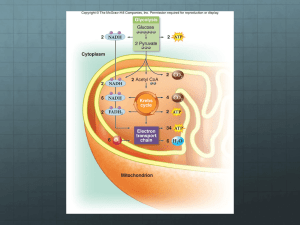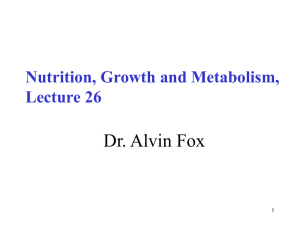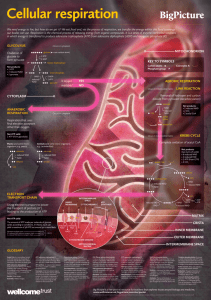Respiration & Photosynthesis exam booklet
advertisement
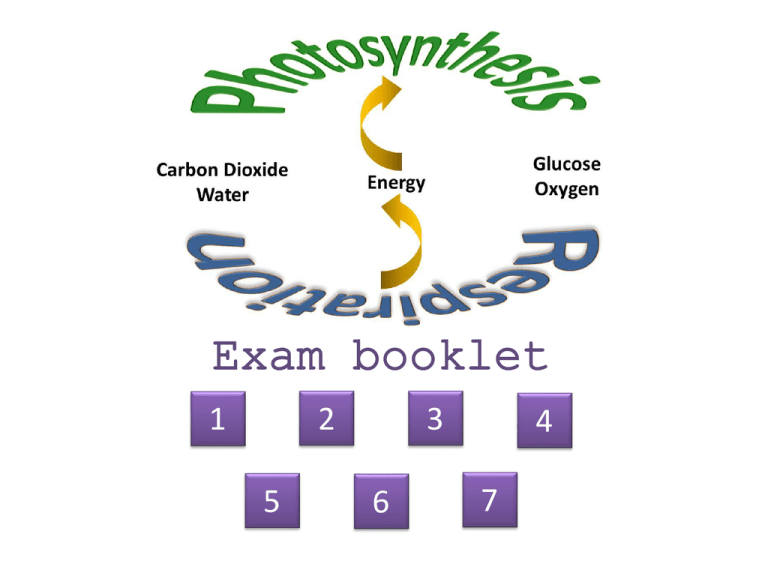
Exam booklet 2 1 5 3 6 4 7 glycolysis Calvin cycle/ light-inde Krebs cycle They take part in different Reactions separated by membr W /glycolysis in cytoplasm X / Calvin cycle in stroma o Y / in matrix of mitochondri There are different enzymes X W and Y ATP; water; NAD / FAD All three needed for 2 mark NAD / FAD / NADP can accept H / be reduced Reduced NAD / FAD carries electrons to the electron transport chain / for oxidative phosphorylation Reduced NAD / FAD carries hydrogen ions / for oxidative phosphorylation / chemiosmosis 2 Fig. 5.1 is an electron micrograph of a leaf mesophyll cell. Several cell structures have been indicated by letters. Some of these produce ATP (a) With reference to Fig. 5.1 (i) identify two organelles in ATP is produced and name these organelles F mitochon 2. identifying letter ……………. B name ………………………………………………………… chloropla 1. identifying letter ……………. name ………………………………………………………… (a) With reference to Fig. 5.1 (ii) explain why the cell is eukaryotic rather than prokaryotic Has a nucleus / nuclear mem ………………………………………………………………………………………………………………………….. Has membrane bound organell ……………………………………………………………………………………………………………………...[2] Has mitochondria / chloropl ………………………………………………………………………………………………………………………….. Photophosphorylation and oxidative phosphorylation are two processes that occur in cells, such as that shown in Fig. 5.1. (b) Describe similarities and differences between oxidative phosphorylation and photophosphorylation ATP synthesised in both ………………………………………………………………………………………………………………………….. With ATP synth(et)ase ………………………………………………………………………………………………………………………….. Both take place on / ………………………………………………………………………………………………………………………….. across membranes ………………………………………………………………………………………………………………………….. Series of electron ………………………………………………………………………………………………………………………….. carriers involved in both ………………………………………………………………………………………………………………………….. Electron flow in both ………………………………………………………………………………………………………………………….. + across Movement of H ………………………………………………………………………………………………………………………….. membranes in both ……………………………………………………………………………………………………………………...[3] 3 (a) NAD, FAD NADPH produced absorbed / / fixed released produced used Small quantity of ‘starter’ substance required Intermediates lead to many other series of reactions Easy to convert substances Without using too many enzymes Any two from: • Two membranes • DNA • Electron carriers • Internal K E E to cristae K to matrix ETC/ transfer of electrons down chain stops Stops phosphorylation / ADP not phosphorylated Krebs cycle stops / no oxidised NAD/FAD /no substrate linked phosphorylation Pyruvate / any Krebs cyc ADP and phosphate form ATP Oxygen used to form water/as Nitrogenous base Adenine Pentose / 5 carbon sugar Ribose Three phosphate groups Any two from: • Anabolic reactions • DNA replicatio n • Protein • Active transport • Electrical conduction • Exocytosis • Movement within ATP synth(et)ase The first three listed f • Cyclic photophosphoryl • Non-cyclic photophosph • Chemiosmosis • Oxidative phosphorylat • Substrate level phosph NAD/FAD involved in respiration 2 molecules of NAD reduced in glycolysis 1 molecule of NAD reduced in the link reaction 1 molecule of NAD reduced in the Krebs cycle NADP involved in photosynthesis Reduced in non-cyclic photophosphorylation Hydrogen comes from photolysis Used in the Calvin cycle / light independent stage QWC mark awarded if three of the following are spelt and used correctly: • • • • • • • Photophosphorylation Glycolysis Calvin cycle Krebs cycle Cristae Photolysis Link reaction Palisade mesophyll Spongy mesophyll 1.73.1 4 .04.74.9 5 .0 CO 2 released is a measure respiration State two figures close t value of 2, therefore supports respiration is Only the value between 5 O C and 15 OC is close Photosynthesis does not support as values not near Light intensity is limiting factor Low rate of photosynthesis Rate of respiration increases at high temperature Rate of respiration is close to /exceeds rate of photosynthesis Calvin cycle Any four from: • rubisco • Some TP • RuBP plus CO 2 forms • Unstable 6C hexose compound sugars formed • Some TP • [2 molecules regenerate Can be an of GP] s RuBP annotated • GP to TP diagram


